| Corcoran Technical Trading Patterns For September 5 |
| By Clive Corcoran |
Published
09/5/2008
|
Stocks
|
Unrated
|
|
|
|
Corcoran Technical Trading Patterns For September 5
In my last letter (published on Wednesday) I expressed my concerns about the weakness being shown by the Nasdaq 100 (^NDX), the imminent threat of a surge in the VIX above a clear downward channel, and the fact that some very large bets were being placed by funds across a wide range of sector funds. Yesterday all three of these trends accelerated in what was a momentous session for the Ultra Short ETF's.
Tracking the daily five percent-plus movers at my tradewithform.com website, it can be seen that with only two exceptions, among the 750 large US equity instruments that I monitor/analyze on a daily basis, only two individual equities were able to gain at least five percent, the rest were moves made by the inverse and leveraged sector funds.
The trend-line violations are now so apparent on the Nasdaq that we seem surely destined for a re-test of levels seen earlier in the year.
Although the charts have always been my primary vehicle for trying to anticipate market directional moves one cannot help sometimes taking notice of some extraordinary developments in the real economy. Apart from Mr. Trichet's comments yesterday about the need for eurozone bankers to shorten their hair, it is becoming more apparent that certain sections of the consumer sector are literally falling off a cliff. Following plunging auto sales reported by Ford earlier this week, UK car manufacturers revealed that August was the worst month for car sales since 1966. Sales of Land Rovers and BMW's have fallen through the floor and anecdotally I noticed in my own neighborhood in the UK a previously owned Range Rover that would have cost about $100k when it was purchased as new less than 2 years ago still sitting in the forecourt of a local showroom unsold with a sticker price of less than one quarter of that original amount.
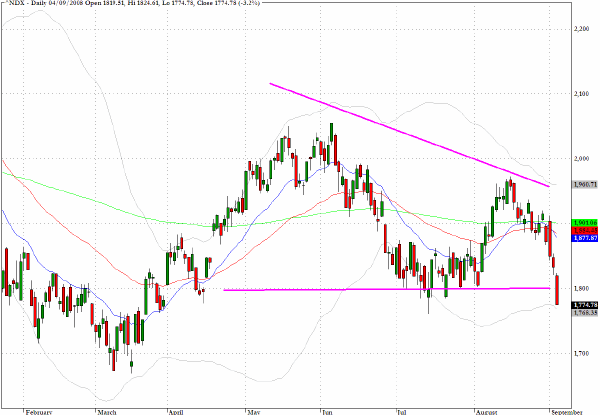
I often review the Russell 2000 (^RUT) at critical moments for the indices and will suffice to say at this stage that the small cap index has still not registered a key breakdown below the 720 pivotal level. However more worrying for a bullish outlook, which is becoming harder to justify execpt on contrarian grounds, is the technical condition of the S&P 400 Midcap Index (^MID) which has broken away from the triangular patterns that were building during August, and which required resolutions when trading volumes picked up in September.
The release of the employment data this morning has the potential to be a further catalyst to sharp movements across a whole range of instruments. However a pattern has been in evidence recently of traders trying to get ahead of the key non-farm payrolls data before its actual release. If, and I am not suggesting that this will happen but there is a possibility, we saw a major reversal upwards in US equities after today's data the last few sessions will have turned out to be a major bear trap.
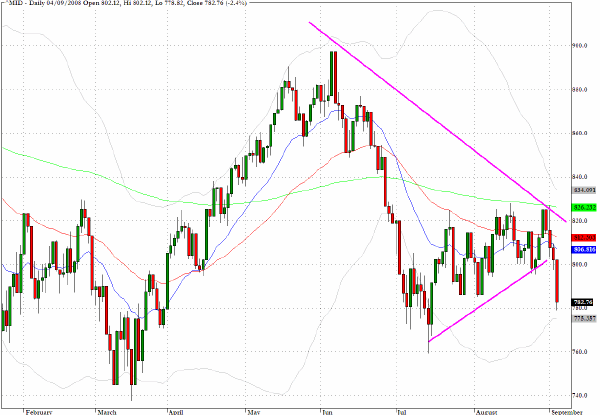
I am simply going to repeat my comments from Wednesday's letter.
One chart that I shall be watching closely is for the CBOE Volatility Index (^VIX) which is now challenging the upper trend-line which tracks a recent decline in the market's anticipation of future volatility. If we see continued weakness in the tech sector, a failure by the Russell 2000 to take on the 760 level, and a break through the VIX channel at the 200-day EMA indicated on the chart below, this would move me away from my intermediate-term positive bias.
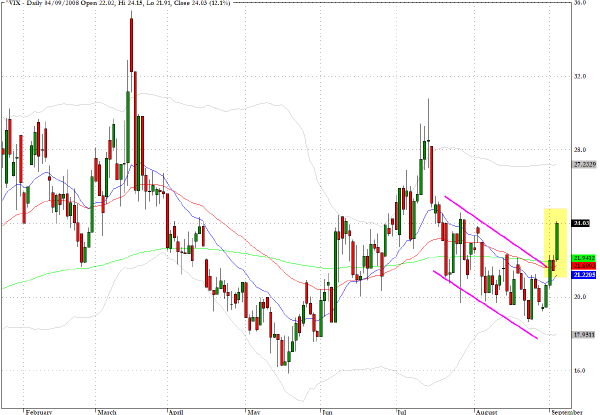
Asian markets fell hard in Friday's session with the Hang Seng down by almost three percent, the Mumbai Exchange Index, the Sensex down by a similar amount and with the Nikkei 225 returning almost to the 12000 level.
The chart pattern for the Nikkei below is remarkably symmetrical showing how the recovery from mid March rallied back to the 200-day EMA almost exactly and has now almost returned to the point at which that recovery began.
One ominous technical signal is that the downward channel since late May/June is broadening out in, what could be called an inverted megaphone. This suggests further downward pressure with heightened volatility ahead.
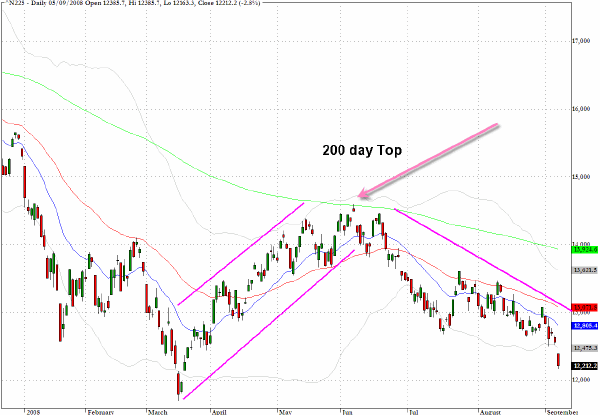
Recent market conditions are reinforcing my predilection towards focusing on the exchange traded funds as their behavior can be less erratic than individual equities. Having said that one has to be somewhat cautious with the leveraged funds but when markets begin to exhibit the kind of sectoral allocation strategies that have now become the norm these Ultra Short funds can be the place to be.
I mentioned in Tuesday's letter, the chart for the Ultra Short Semiconductor fund, SSG, was suggesting that large players were building position anticipating further weakness for the semis. The last two days alone would have returned about 15%.
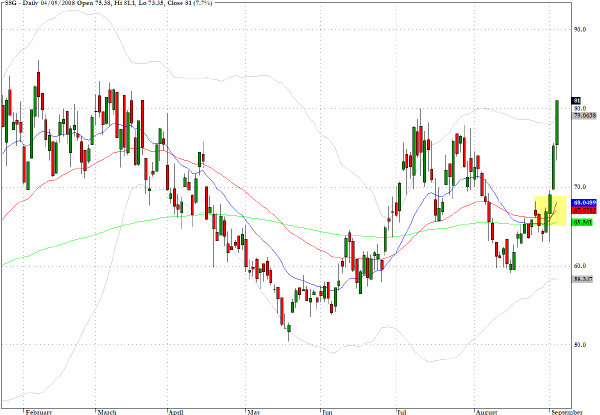
One exchange traded fund that I have not discussed here previously is DBV which goes under the slightly enigmatic moniker of the Power Shares G10 Currency Harvest. In essence it tracks the high yielding currencies and performs well when currencies such as the Australian dollar, New Zealand dollar and to some extent UK sterling are out-performing the lower yielding currencies which has at present to include the US dollar.
As can be seen from the chart this fund has tanked in line with the collapses in those high yielding currencies.
A month ago in a television interview I suggested that the Australian dollar was headed down from parity with the US dollar to about 82 cents. We are almost there and I am beginning to sense that the rout in these currencies and the almost uninterrupted ascent of the dollar looks a bit overdone in the near term.
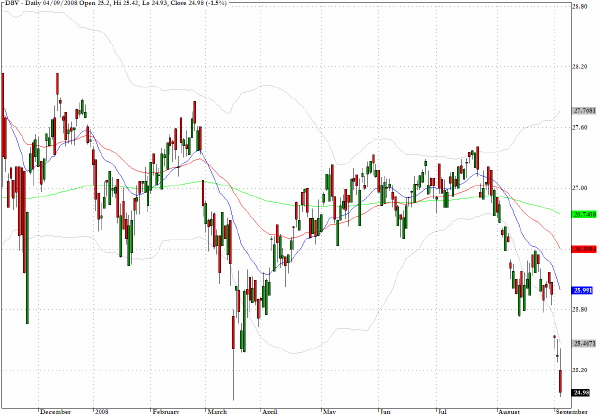
As with all long/short strategies, one is expecting the selection of sector instruments for straddling both sides of the market to produce both winners and losers. I had previously suggested that EFU, which is an inverse play on the Emerging Markets Index, looked somewhat toppy but that call turned out to be poorly timed. However I did also point recently to the potential for FXP, which is a short instrument for the Chinese markets, to return to the 100 level which it did yesterday.
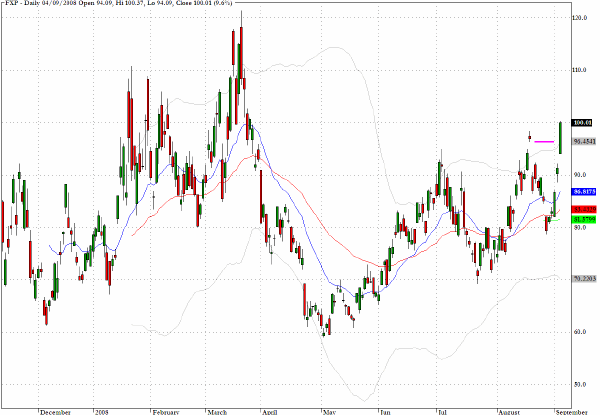
Also covered in Wednesday's letter was a comment on IXN which comprises stocks from global technology. I suggested that the fund was exhibiting corrective patterns that could suggest a return to levels seen in July and previously in March and we are on the verge of reaching those levels.

Clive Corcoran is the publisher of TradeWithForm.com, which provides daily analysis and commentary on the US stock market. He specializes in market neutral investing and and is currently working on a book about the benefits of trading with long/short strategies, which is scheduled for publication later this year.
Disclaimer
The purpose of this article is to offer you the chance to review the trading methodology, risk reduction strategies and portfolio construction techniques described at tradewithform.com. There is no guarantee that the trading strategies advocated will be profitable. Moreover, there is a risk that following these strategies will lead to loss of capital. Past results are no guarantee of future results. Trading stocks and CFD's can yield large rewards, but also has large potential risks. Trading with leverage can be especially risky. You should be fully aware of the risks of trading in the capital markets. You are strongly advised not to trade with capital.
|